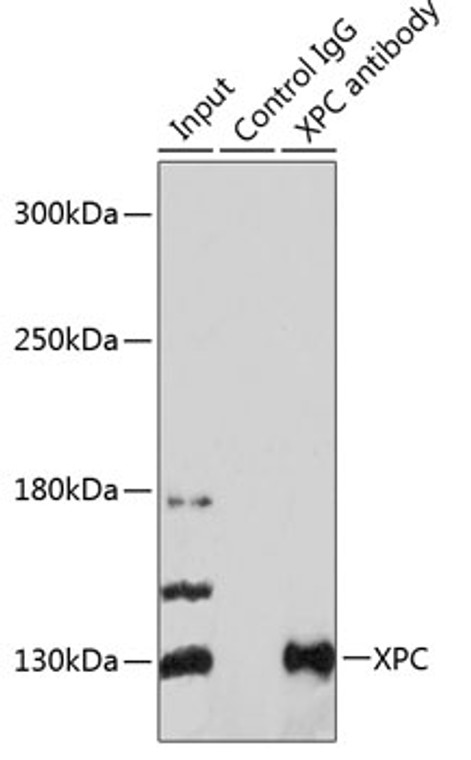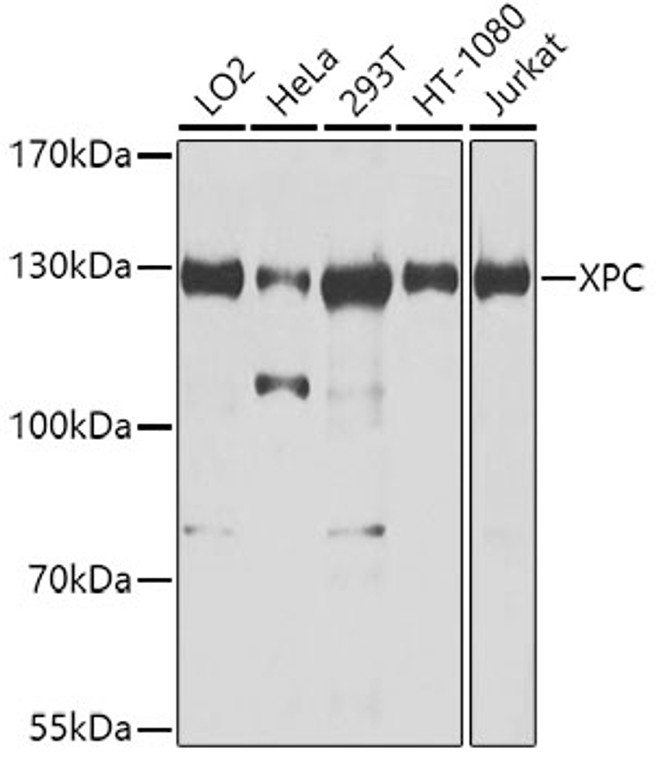| Host: |
Rabbit |
| Applications: |
WB/IHC/IP |
| Reactivity: |
Human |
| Note: |
STRICTLY FOR FURTHER SCIENTIFIC RESEARCH USE ONLY (RUO). MUST NOT TO BE USED IN DIAGNOSTIC OR THERAPEUTIC APPLICATIONS. |
| Short Description: |
Rabbit polyclonal antibody anti-XPC (700-940) is suitable for use in Western Blot, Immunohistochemistry and Immunoprecipitation research applications. |
| Clonality: |
Polyclonal |
| Conjugation: |
Unconjugated |
| Isotype: |
IgG |
| Formulation: |
PBS with 0.02% Sodium Azide, 50% Glycerol, pH7.3. |
| Purification: |
Affinity purification |
| Dilution Range: |
WB 1:500-1:2000IHC-P 1:50-1:200IP 1:50-1:100 |
| Storage Instruction: |
Store at-20°C for up to 1 year from the date of receipt, and avoid repeat freeze-thaw cycles. |
| Gene Symbol: |
XPC |
| Gene ID: |
7508 |
| Uniprot ID: |
XPC_HUMAN |
| Immunogen Region: |
700-940 |
| Immunogen: |
Recombinant fusion protein containing a sequence corresponding to amino acids 700-940 of human XPC (NP_004619.3). |
| Immunogen Sequence: |
GEVPYKMVKGFSNRARKARL AEPQLREENDLGLFGYWQTE EYQPPVAVDGKVPRNEFGNV YLFLPSMMPIGCVQLNLPNL HRVARKLDIDCVQAITGFDF HGGYSHPVTDGYIVCEEFKD VLLTAWENEQAVIERKEKEK KEKRALGNWKLLAKGLLIRE RLKRRYGPKSEAAAPHTDAG GGLSSDEEEGTSSQAEAARI LAASWPQNREDEEKQKLKGG PKKTKREKKAAASHLFPFE |
| Post Translational Modifications | Ubiquitinated upon UV irradiation.the ubiquitination requires the UV-DDB complex, appears to be reversible and does not serve as a signal for degradation. Ubiquitinated by RNF11 via 'Lys-63'-linked ubiquitination. Ubiquitination by RNF111 is polysumoylation-dependent and promotes nucleotide excision repair. Sumoylated.sumoylation promotes ubiquitination by RNF111. |
| Function | Involved in global genome nucleotide excision repair (GG-NER) by acting as damage sensing and DNA-binding factor component of the XPC complex. Has only a low DNA repair activity by itself which is stimulated by RAD23B and RAD23A. Has a preference to bind DNA containing a short single-stranded segment but not to damaged oligonucleotides. This feature is proposed to be related to a dynamic sensor function: XPC can rapidly screen duplex DNA for non-hydrogen-bonded bases by forming a transient nucleoprotein intermediate complex which matures into a stable recognition complex through an intrinsic single-stranded DNA-binding activity. The XPC complex is proposed to represent the first factor bound at the sites of DNA damage and together with other core recognition factors, XPA, RPA and the TFIIH complex, is part of the pre-incision (or initial recognition) complex. The XPC complex recognizes a wide spectrum of damaged DNA characterized by distortions of the DNA helix such as single-stranded loops, mismatched bubbles or single-stranded overhangs. The orientation of XPC complex binding appears to be crucial for inducing a productive NER. XPC complex is proposed to recognize and to interact with unpaired bases on the undamaged DNA strand which is followed by recruitment of the TFIIH complex and subsequent scanning for lesions in the opposite strand in a 5'-to-3' direction by the NER machinery. Cyclobutane pyrimidine dimers (CPDs) which are formed upon UV-induced DNA damage esacpe detection by the XPC complex due to a low degree of structural perurbation. Instead they are detected by the UV-DDB complex which in turn recruits and cooperates with the XPC complex in the respective DNA repair. In vitro, the XPC:RAD23B dimer is sufficient to initiate NER.it preferentially binds to cisplatin and UV-damaged double-stranded DNA and also binds to a variety of chemically and structurally diverse DNA adducts. XPC:RAD23B contacts DNA both 5' and 3' of a cisplatin lesion with a preference for the 5' side. XPC:RAD23B induces a bend in DNA upon binding. XPC:RAD23B stimulates the activity of DNA glycosylases TDG and SMUG1. In absence of DNA repair, the XPC complex also acts as a transcription coactivator: XPC interacts with the DNA-binding transcription factor E2F1 at a subset of promoters to recruit KAT2A and histone acetyltransferase complexes (HAT). KAT2A recruitment specifically promotes acetylation of histone variant H2A.Z.1/H2A.Z, but not H2A.Z.2/H2A.V, thereby promoting expression of target genes. |
| Protein Name | Dna Repair Protein Complementing Xp-C CellsXeroderma Pigmentosum Group C-Complementing ProteinP125 |
| Database Links | Reactome: R-HSA-3108214Reactome: R-HSA-5696394Reactome: R-HSA-5696395 |
| Cellular Localisation | NucleusChromosomeCytoplasmOmnipresent In The Nucleus And Consistently Associates With And Dissociates From Dna In The Absence Of Dna DamageContinuously Shuttles Between The Cytoplasm And The NucleusWhich Is Impeded By The Presence Of Ner Lesions |
| Alternative Antibody Names | Anti-Dna Repair Protein Complementing Xp-C Cells antibodyAnti-Xeroderma Pigmentosum Group C-Complementing Protein antibodyAnti-P125 antibodyAnti-XPC antibodyAnti-XPCC antibody |
Information sourced from Uniprot.org
12 months for antibodies. 6 months for ELISA Kits. Please see website T&Cs for further guidance












